List of Authors
>>About this blog
Recent blog post
|
[Silver]
March 21, 2014 14:00
Everybody came from a rural area to reach Nihonbashi.
In sankin kotai during the Edo period, only the three clans of Shinano, Takashima, Takato and Iida used Koshu Kaido.
Kiyonari Naito, the second head of the Takato Domain, who had the confidence of Ieyasu Tokugawa, was the lord of the Tokugawa family.
It is said that when Ieyasu entered Edo in 1590, Kiyoshige and Tadanari Aoyama examined the land around Edo in advance and welcomed Ieyasu.
The purpose of this achievement is to protect the important traffic points west of Edo Castle.
The current land of Shinjuku Gyoen has been given to Kiyoshige as "Yotsuya Yashiki". (See Shinjuku Cultural Map)
That said, today we decided to aim for Nihonbashi from Shinjuku 3-chome via Yotsuya, Kojimachi and Hanzomon through the moat of the Imperial Palace.
Of course, the purpose is not only healthy walking, but also a certain restaurant   in Nihonbashi. in Nihonbashi.
At Shinjuku Sanchome, I saw  the picture of "Yotsuya Naito Shinjuku", one of the 100 famous Edo scenes of Hiroshige Utagawa, and imagined the streets of the time. the picture of "Yotsuya Naito Shinjuku", one of the 100 famous Edo scenes of Hiroshige Utagawa, and imagined the streets of the time.
Ah, I finally came to see Cored Nihonbashi. Turn left here and it's Nihonbashi right away.
Well, where would you like to have a cup of "Thank you"?
Would you like  to stop by the newly opened restaurants of Chored Muromachi 2 and 3 on March 20? to stop by the newly opened restaurants of Chored Muromachi 2 and 3 on March 20?

Postscript: In early March, when I walked from Nihonbashi to Shinjuku 3-chome, it was just 2 hours.
Shinjuku has a height of about 20m above sea level, so this time it took less than 2 hours to walk slowly.
[Silver]
March 18, 2014 18:00
The title of today's blog was a little bit shy and a short song.
I would be happy if you could praise me when it expresses the feeling of spring.
By the way, the  cherry blossoms at Tsukiji River Park next to St. Luke's College of Nursing have bloomed cherry blossoms at Tsukiji River Park next to St. Luke's College of Nursing have bloomed . .
In this same garden, many  Yoshino cherry tree Yoshino cherry tree blooms from the end of March. blooms from the end of March.
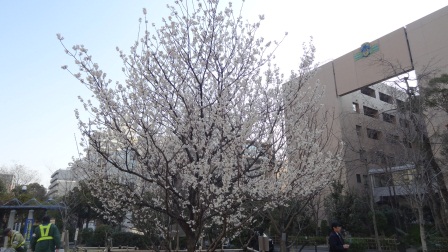
For a moment, if you go to Tsukiji Market,
"Renkyo" in the photo below and the pretty white kodama "Yukiyanagi" are also beginning to bloom.
It's a nice spring. spring.
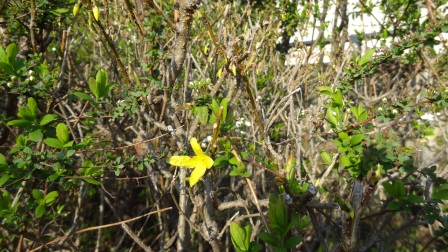
If you go down from St. Luke's Tower to the Sumida River Terrace, you will see the leaves like a clover.
"Katabami" blooms pretty yellow flowers.
Please drop in  during St. Luke Street during St. Luke Street , shopping , shopping  at Tsukiji, or a gastronomy restaurant. at Tsukiji, or a gastronomy restaurant.
[Silver]
March 15, 2014 14:00
Looking at Kidai Shoran in Nihonbashi, I expanded my dream of traveling to Nikko and Oshu Kaido and started walking.
Turn right at the corner of Nihonbashi Yuito and go straight.
This corner is in front of Murata Glasses Store, Japan's first eyeglass specialty store. eyeglass specialty store.
There are buildings of major pharmaceutical companies on both sides. When you come to the "medicine museum"
I hit a highway. Beyond the highway, you can see Ozu Washi's store building.
Cross the pedestrian crossing at Honmachi 2-chome or Honmachi 3-chome.
Then go straight ahead with Ozu Washi's building on your left.
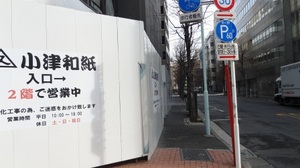
The opposite of Edoya, a brush specialty store that has continued since the Edo period, is currently a parking lot.
In one corner, there is a bronze stone monument. This is the Nikko Kaido signpost.
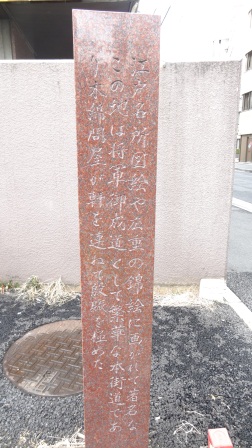
If you go straight, you will find a wholesale district in Yokoyamacho, follow the road and you will reach the intersection of Asakusabashi.
Here, use  the underpass to go to Asakusabashi and Asakusa Mitsuke ruins. the underpass to go to Asakusabashi and Asakusa Mitsuke ruins.
 At the police box, there is an explanation version of the ruins of the Gundai mansion, Asakusabashi and Asakusa Mitsuke. At the police box, there is an explanation version of the ruins of the Gundai mansion, Asakusabashi and Asakusa Mitsuke.
Rather than simply walking honestly on the Nikko Kaido,
Visit Ozu Washi's gallery, visit the Satake Dainichi Nyorai wells behind the building, and visit Takarada Ebisu Shrine.
I think it would be good to listen to the bell at Jisshi Park, the ruins of the Kodemmacho prison Ishide sword, and the regrettable voice of the former prisoner of Yoshida Shoin.
To accompany your trip, it is recommended that you walk with an old map or the 100 famous Edo views of Hiroshige Ando.
You can also purchase a book with 100 famous views of Edo in one book at   the Chuo-ku Tourism Association (the number is limited, please check it.) Telephone (03-6228-7907) the Chuo-ku Tourism Association (the number is limited, please check it.) Telephone (03-6228-7907)
Let's have a good trip! 
[Silver]
March 11, 2014 09:00
Today, I'll show you around Nakasendo from Nihonbashi.
First of all, let's study the streets of the Edo period by looking at Kidai Shoran on the underground passage of Nihonbashi Mitsukoshi.
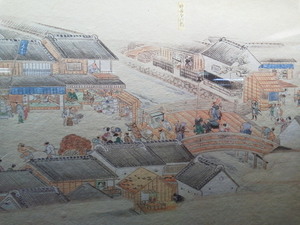 (From "Kidai Shoran" at Mitsukoshimae Station) (From "Kidai Shoran" at Mitsukoshimae Station)
Cross the intersection of Muromachi 3-chome while looking at the site of Senbikiya Sohonten, Ebiya Art Store, and Juken Store.
Oops, let's take a look at the explanation of the ruins of Nagasakiya in front of JR Shin-Nihonbashi Station on the right side.
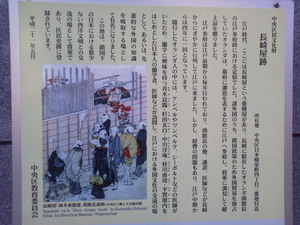
Then, look at the information board such as the ruins of the bell tower in Kokumachi, and follow the original road on the left side toward Kanda at the next traffic light.
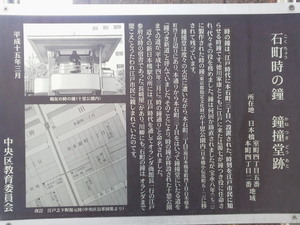
On the side of the road on the left (now in front of Honma Golf), there is a stone monument to guide the site of Imagawa Bridge.
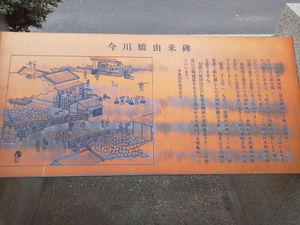
At that time, I went on thinking that it was such a street. After a while, you will leave in front of JR Kanda Station.
Let's check on an old map explaining the famous Edo Hundred Views that this area had a strange gate and that Shohei Bridge was also during the Kaei era.
From here, you can easily reach Itabashi-juku on a modern version of the map.
At the site of Itabashi-juku, Itabashi sightseeing volunteers will welcome you warmly.
Address: 3-14-15 Itabashi, Itabashi-ku, telephone 03-3963-5078
On March 11, 2011, I remember walking on a dark night road from Nihonbashi to this Itabashi-juku.
Do you remember the directions so that you can return from your office to your home on foot?
Once again, I pray for the recovery of the affected areas as soon as possible and the health of the affected people.
In addition, I hope my friends and my wife's high school classmates and family will move forward with the spirit of Tohoku. When you're tired, go out to Tokyo.
[Silver]
March 3, 2014 09:00
I was walking on Ginza Street today and came to "Ganko Ginza 1-chome store".
I've used this a few times at the year-end party, but recently I've been around for a long time.
This is the 50th anniversary of our founding. Congratulations.
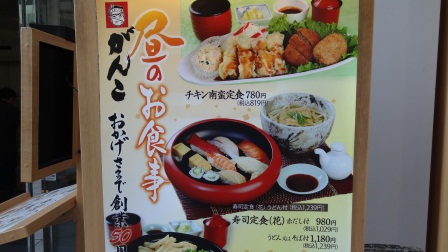
The lunch at this shop is full of variety, delicious, and cheap.
If you introduce the menu, (as of February 2014, consumption tax is excluded. Udon OR soba is added 200 yen separately), chicken nanban set meal 780 yen, sushi set meal (flower) 980 yen, sashimi set meal 980 yen, steak set meal 880 yen, etc.
Look at the entrance "Nabeyaki udon / green onion toro set meal 980 yen" and inside the store.
Then, when I entered the store, I changed my mind and "Unagi Seiro tempura set meal 1,380 yen"
Tempura consists of two shrimp tempura, lotus root, eggplant, pumpkin, and shishito.
The eel is 4 pieces, but it was cooked easy to eat and it was very delicious.
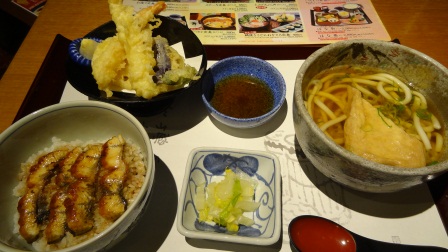
I wonder if the next lunch is warm  "Nabeyaki udon". At night, let's come to eat "Fuguchiri: 2,680 yen per person". "Nabeyaki udon". At night, let's come to eat "Fuguchiri: 2,680 yen per person".
The shop is located at 1-7-10 Ginza, Chuo-ku, B1 and B2 (south of the Paula Museum) of the Hulic Ginza Building, where Mizuho Bank is located.
Phone: 03-3567-6789 I recommend silver.
When I tried to put on my shoes , there was a stone pillar. According to the shop, it is a stone pillar of the bridge in Kyoto. , there was a stone pillar. According to the shop, it is a stone pillar of the bridge in Kyoto.
I found something unusual. I also have to check the history next time.
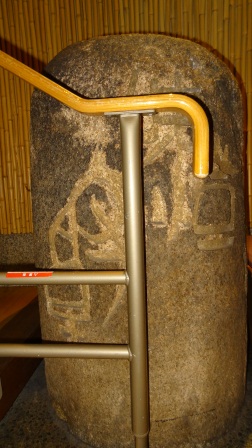
[Silver]
March 2, 2014 09:00
A long time ago, during the Edo period, Ieyasu Tokugawa designated Nihonbashi as the first departure place on Gokaido.
At present, many people know that the "Japan Road Mark" is buried in the center of the road in Nihonbashi.
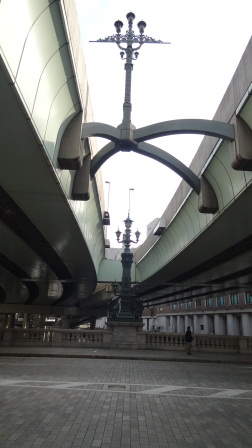
Many people leave from Nihonbashi on a walk along the five highways, including Tokaido.
However, it is very regrettable to come to Nihonbashi just as a starting point for walking.
Nihonbashi has a history of over 400 years of bridges, and there are many long-established stores with a history of over 300 years in the surrounding area.
Why don't you leave after buying a commemorative souvenir at a long-established tour in Nihonbashi or having lunch at a famous store with extra hour? at a famous store with extra hour?
The people in Niigata and Tokyo metropolitan areas that I have guided you to.
At the Mitsukoshi Nihonbashi store, I went shopping and got a stamp to commemorate the visit.
http://www.eitaro.com/index.html Candy with the motif of Nihonbashi in Eitaro Sohonpo.
I saw Mr. Kuroeya's giboshi and bought "Nihonbashi"
There are many people who are happy to go out, so I would like to introduce you a little. to go out, so I would like to introduce you a little.
The best way to learn about the history of Nihonbashi is to see and understand.
In that case, at the "Heidai Shoran" installed at the concourse of Tokyo Metro Mitsukoshimae Station.
It's a good idea to feel the atmosphere of the old street.
Also, in order to get to know the current Tokyo from a high point, it is necessary to look at Tokyo.
At the restaurant "Kesiki" on the 38th floor of Hotel Mandarin Oriental, you can enjoy a relaxing meal and the surrounding scenery before leaving for a walk on Gokaido.
Of course, it is also recommended that you eat at restaurants in Choledo Muromachi and Choledo Nihonbashi and famous restaurants such as Taimeiken to make good memories before going out.
I don't forget to visit  the the  Bank of Japan and Bank of Japan and  the Money Museum around Nihonbashi. the Money Museum around Nihonbashi.
Go around the bridge,
In the square of the bridge, you can see replicas of the road markings and schedules to various places.
Look at the explanation of Otohime Square  and the ruins of the Takafuda, which informs and the ruins of the Takafuda, which informs   you of the remnants of the fish market, and explore Nihonbashi and have fun departure. you of the remnants of the fish market, and explore Nihonbashi and have fun departure.
Let's have a good trip!
1
|
Links
|
![]()
![]()
![]() in Nihonbashi.
in Nihonbashi.![]() the picture of "Yotsuya Naito Shinjuku", one of the 100 famous Edo scenes of Hiroshige Utagawa, and imagined the streets of the time.
the picture of "Yotsuya Naito Shinjuku", one of the 100 famous Edo scenes of Hiroshige Utagawa, and imagined the streets of the time.![]() to stop by the newly opened restaurants of Chored Muromachi 2 and 3 on March 20?
to stop by the newly opened restaurants of Chored Muromachi 2 and 3 on March 20?![]()












